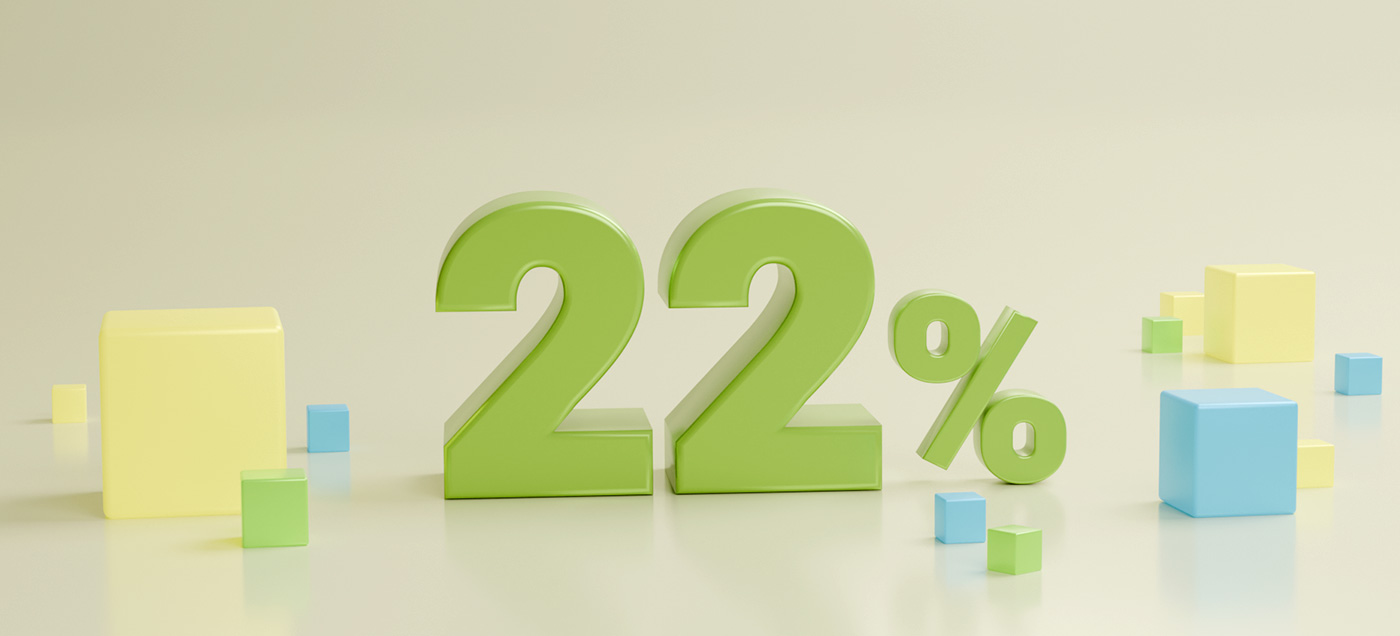As we approach the new year, we must all prepare for the updated VAT rate of 22%. This brief overview outlines the adjustments within SmartAccounts due to this change, and highlights areas needing attention.
-
- 22% VAT rate on sales invoices
- Quotes and sales orders
- 22% VAT rate on purchase invoices
- New VAT return form
- Items – new VAT rate
- Clients and vendors – new VAT rate
- Recurring invoices – new VAT rate
- VAT return settings
- Chart of accounts
- Default accounts
- Item names
- Recommendations
- Transitional provisions
- VAT rate and SmartAccounts’ pricing
- API services
22% VAT rate on sales invoices
As of today, SmartAccounts implements a new system wide VAT rate of 22%. This VAT rate can be used on sales invoices provided that the invoice entry date falls in the year 2024 or later. However, it is allowed to save an invoice with, for example, a December date, but with an entry date in January (2024).
The reason why entering transactions at a 22% rate in 2023 is prohibited is that the December VAT return is still submitted on the old form, which lacks rows for declaring transactions with a 22% rate.
NOTE! We will add an error message to the application if:
-
- 22% rate is used in December
Later, a warning will be added if:
-
- 20% rate is used in January*
*Under certain conditions, entering transactions at a 20% rate in January is still allowed.
What to do if you have already created your own 22% VAT rate?
If you have previously created a company-specific VAT rate of 22%, you should proceed as follows:
-
- Change the VAT rate you created on the documents to the new VAT rate of 22%.
- The correct system wide VAT rate is the second one in the VAT rate selection (the user-created VAT rate is further down the list). This allows you to select the correct VAT rate for the document.
- NOTE! Company-specific VAT rates do not automatically reach the VAT return. Starting from 2024, only those documents using SmartAccounts’ system wide VAT rate of 22% will be automatically declared.
Quotes and sales orders
It is possible to use the new VAT rate on quotes and sales orders already in December, but it is important to ensure that the final rate used on the invoice created from the offer or order is correct. If necessary, the user must manually change this.
22% VAT rate on Purchase invoices
New VAT rates for purchase invoices will be added to the application in the second half of December, and the logic of their use is exactly the same as for sales invoices:
-
- Invoices with the 22% rate can be created if the entry date is after 2023.
- Invoices with the 22% rate are not allowed if the entry date is before 2024.
What to do if you receive an incorrect invoice from a supplier?
If you receive a December-dated purchase invoice from a supplier using a 22% VAT rate, check with the supplier if the VAT rate is correct. If the information is accurate and the invoice VAT rate indeed needs to be 22%, then the entry date for the purchase invoice in SmartAccounts must be set to January 2024 (as it is not possible to enter documents with a 22% VAT rate in December).
New VAT return form
The new VAT return form will be added to the application during December. Until then, it is not possible to prepare the 2024 VAT declaration yet. The new form will declare data from January 2024 onwards, so the first time to submit a declaration with the new data is in February 2024.
The December VAT declaration, due on January 20th, will still be submitted using the old VAT declaration form, which lacks transactions with the 22% VAT rate.
Automatic VAT rate changes
In mid-December, we will add the possibility to automatically overwrite the VAT rates of existing:
-
- items
- customers and vendors
- recurring invoice contracts
NOTE! The data overwriting can be confirmed by a user with company administrator rights.
Items – new VAT rate
We will add the option to overwrite at once all those items’ VAT rates, which have a VAT rate of 20% set on the article card (or one of the other six remaining 20% rates -> 20% (reverse charge) will be overwritten with a 22% (reverse charge) rate, etc.). Automatic overwriting can be:
-
- done immediately upon displaying the message
- done later with the click of a button
Starting from January, new articles added will automatically have a default VAT rate of 22%.
Clients and vendors – new VAT Rate
We will add the option to overwrite at once all VAT rates set on clients’ and suppliers’ cards. Automatic overwriting can be:
-
- done immediately upon displaying the message
- done later with the click of a button
Recurring Invoices – new VAT Rate
We will add the option to overwrite at once all those recurring periodic contracts’ VAT rates, which have a VAT rate of 20% set on the invoice lines. Automatic overwriting can be:
-
- done immediately upon displaying the message
- done later with the click of a button
VAT return settings
If transactions have been added to the VAT return on the VAT return settings page (Settings – VAT return settings) using a formula, these formulas must be reviewed before preparing the VAT return for January 2024.
Since the new line for declaring transactions at a 22% rate will replace the line for 20% rate transactions (line 1), and 20% rate transactions will be declared on a new line (line 1 1), it should be ensured that line 1 contains those transactions that must reach the declaration at a 22% rate and line 1 1 accordingly those transactions that are still declared at 20% (if such transactions exist).
Chart of accounts
We will not automatically make changes to the chart of accounts for existing companies, which means that in 2024 the chart of accounts will still have an account named “Revenue from the Sale of Services in Estonia (VAT 20%)” (one of the default account names in the chart of accounts).
If an account with a similar name is in use, there are 3 options:
-
- change the account name in the chart of accounts and overwrite it with the new rate
- change the account name in the chart of accounts and remove the reference to the VAT rate from the name altogether (make the revenue account name more general – for example, “Revenue from the Sale of Services in Estonia”)
- enter a new account into the chart of accounts and use a new account with the new name from 2024 onwards.
NOTE! This account must then also be set as the sales account on the article card.
New companies entered into the application from 2024 will receive an updated chart of accounts, which will already include revenue accounts with new names.
Default accounts
If new revenue accounts have been added to the chart of accounts, which are intended to be used as the default for sales articles in the future, then the default article sales account should be changed on the default accounts page (Settings – Default Accounts).
This is necessary only to ensure that when creating a new sales article, the account does not have to be changed manually, but the default sales account already set will be used.
Item names
We also will not automatically make changes to the list of articles for existing companies, which means that in 2024 the list of articles will still have the same names. If default sales articles are in use and specifically named, for example, ‘Service 20%’, then, similar to the chart of accounts, there are 3 options here as well:
- change the article name and overwrite it with the new rate
- change the article name and remove the reference to the VAT rate from the name altogether (make the article name more general)
- enter a new article and use a new article from 2024 onwards.
New companies entered into the application from 2024 will receive an updated default list of articles, which will already include articles with new names.
Recommendations
Rate changes
The general recommendation when changing VAT rates is to use the automatic rate overwriting option offered by the application. In this case, from the new year onwards, articles, clients-suppliers (if a default rate has been added to them), and periodic contracts will have new VAT rates.
Of course, the VAT rate can also be changed manually before the automatic change option is available.
Chart of accounts
If it is not important to show transactions at a 22% rate on a new revenue account in the new year, then the name in the chart of accounts can simply be changed (it should be noted, however, that the account name changes retroactively on documents. Therefore, we recommend changing the account name to something more general (“Revenue from Sale of Purchased Goods in Estonia”)).
Recurring invoices
For recurring invoices, we recommend thinking well in advance about the VAT rate with which invoices compiled through periodic contracts will be sent to clients in December and January. If necessary, the VAT rate on recurring invoices can be changed manually in advance.
If due to the change in the VAT rate, new recurring invoices need to be prepared for all clients, then a new recurring invoice with the same content can be copied for all selected clients based on one recurring invoice. To do this, open the recurring invoice (Sales/purchases – Recurring invoices), click ‘Copy to many’ on the button bar, and then select the clients to whom the same contract will be copied.
Transition Provisions:
In connection with this amendment, the VAT Act contains two transitional provisions.
- Until 31 December 2025, provided that the goods or services supplied are subject to a standard VAT rate, the user of cash accounting of VAT may pay VAT at the rate of 20% on the supply of the goods or services generated after 31 December 2023 if an invoice was issued to the purchaser and the goods were dispatched or made available or the service was supplied before 1 January 2024.
- The second transitional provision concerns transactions relating to long-term contracts, in particular transactions relating to immovables. Until 31 December 2025, a taxable person will be entitled, on the basis of a written contract concluded before 1 May 2023, to apply the 20% VAT rate applicable on the supply of goods or services until 31 December 2023, provided that the relevant contract provides that the price of the goods or services includes VAT at a rate of 20% or VAT at the rate of 20% is added to the price and the contract does not provide for a change in the price resulting from a possible change in the rate of VAT.
Source: https://www.emta.ee/en/business-client/taxes-and-payment/value-added-tax#from-01012024
VAT and SmartAccounts’ pricing
From 1 January 2024, the standard rate of VAT in Estonia is 22% instead of the current 20%. This change will subsequently impact the prices of services listed in SmartAccounts’ price list. Therefore, from January 1, 2024, all services subject to VAT will be taxed at the new rate of 22%.
API services
If you’ve developed an interface for SmartAccounts’ API, it’s essential to adapt to the new 22% VAT rate regulations to maintain smooth functionality.
Key aspects to consider include the shift to a 22% default VAT rate from next year and the prohibition of using a 22% VAT rate for sales and purchase invoices during 2023.







